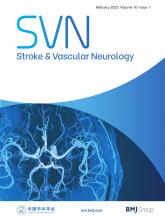Open Access
Remote ischaemic conditioning for stroke: unanswered questions and future directions
Sheharyar Baig, Bethany Moyle, Krishnan Padmakumari Sivaraman Nair, Jessica Redgrave, Arshad Majid, Ali Ali
DOI: 10.1136/svn-2020-000722 Published 26 April 2021
Sheharyar Baig
1Cerebrovascular Medicine, The University of Sheffield Institute for Translational Neuroscience, Sheffield, UK
Bethany Moyle
1Cerebrovascular Medicine, The University of Sheffield Institute for Translational Neuroscience, Sheffield, UK
Krishnan Padmakumari Sivaraman Nair
2Neurosciences, Sheffield Teaching Hospitals NHS Foundation Trust, Sheffield, UK
Jessica Redgrave
1Cerebrovascular Medicine, The University of Sheffield Institute for Translational Neuroscience, Sheffield, UK
Arshad Majid
3Faculty of Medicine and Dentistry, University of Sheffield, Sheffield, UK
Ali Ali
4Geriatrics and Stroke Medicine, Sheffield Teaching Hospitals NHS Foundation Trust, Sheffield, UK
5Sheffield NIHR Biomedical Research Centre, The University of Sheffield, Sheffield, UK

No eLetters have been published for this article.
Remote ischaemic conditioning for stroke: unanswered questions and future directions
Sheharyar Baig, Bethany Moyle, Krishnan Padmakumari Sivaraman Nair, Jessica Redgrave, Arshad Majid, Ali Ali
Stroke and Vascular Neurology Mar 2021, svn-2020-000722; DOI: 10.1136/svn-2020-000722





